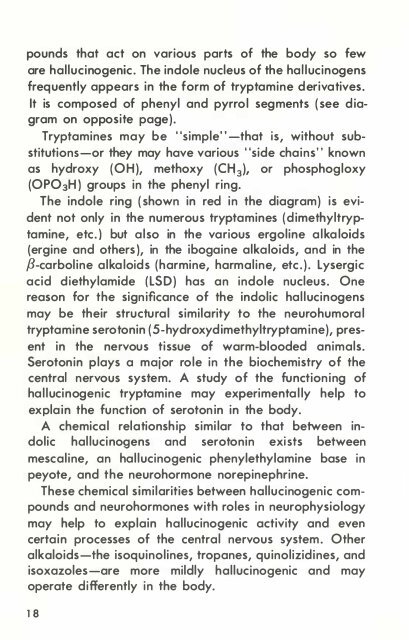3S9rydC3U
3S9rydC3U
3S9rydC3U
You also want an ePaper? Increase the reach of your titles
YUMPU automatically turns print PDFs into web optimized ePapers that Google loves.
pounds that act on various parts of the body so feware hallucinogenic. The indole nucleus of the hallucinogensfrequently appears in the form of tryptamine derivatives.It is composed of phenyl and pyrrol segments (see diagramon opposite page).Tryptamines may be "simple" -that is, without substitutions-orthey may have various "side chains" knownas hydroxy (OH), methoxy (Oh), or phosphogloxy(OP03H) groups in the phenyl ring.The indole ring (shown in red in the diagram) is evidentnot only in the numerous tryptamines (dimethyltryptamine,etc.) but also in the various ergoline alkaloids{ergine and others), in the ibogaine alkaloids, and in the,8-carboline alkaloids (harmine, harmaline, etc.). lysergicacid diethylamide (lSD) has an indole nucleus. Onereason for the significance of the indolic hallucinogensmay be their structural similarity to the neurohumoraltryptamine serotonin (5-hydroxydimethyltryptamine), presentin the nervous tissue of warm-blooded animals.Serotonin plays a major role in the biochemistry of thecentral nervous system. A study of the functioning ofhallucinogenic tryptamine may experimentally help toexplain the function of serotonin in the body.A chemical relationship similar to that between indolichallucinogens and serotonin exists betweenmescaline, an hallucinogenic phenylethylamine base inpeyote, and the neurohormone norepinephrine.These chemical similarities between hallucinogenic compoundsand neurohormones with roles in neurophysiologymay help to explain hallucinogenic activity and evencertain processes of the central nervous system. Otheralkaloids-the isoquinolines, tropanes, quinolizidines, andisoxazoles-are more mildly hallucinogenic and mayoperate differently in the body.18


